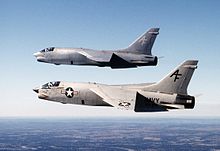The F-8 Crusader, often dubbed “The Last of the Gunfighters,” earned its place in aviation history as a formidable aircraft during the Cold War. However, for all its accolades, the Crusader had its share of flaws that made it a challenging machine to fly and maintain. Here are 10 things that sucked about the F-8 Crusader:
1. Unforgiving Handling at Low Speeds
The F-8 Crusader was notorious for its poor low-speed handling, especially during takeoff and landing. The aircraft’s high landing speed, combined with its unique variable-incidence wing, made it a handful for pilots, particularly on aircraft carriers. A slight miscalculation could lead to a dangerous stall or crash.
2. Landing Gear Woes
The F-8’s landing gear was notoriously fragile and prone to failure. Its narrow, spindly legs often struggled to withstand the stresses of carrier landings, leading to frequent collapses and forcing pilots to execute dicey landings on a regular basis.

3. Engine Reliability Issues
The Pratt & Whitney J57 engine powering the F-8 Crusader was powerful, but it was also plagued by reliability issues. Engine failures were not uncommon, and many pilots had to deal with mid-flight emergencies due to sudden engine problems, a terrifying prospect at high speeds.
4. Maintenance Nightmares
The Crusader was a maintenance-intensive aircraft. Its complex design, particularly the variable-incidence wing and intricate avionics, meant that ground crews had to spend long hours keeping the jet in working order. This high maintenance burden often led to reduced availability and operational readiness.
5. Limited Fuel Capacity
Despite its impressive speed and firepower, the F-8 Crusader suffered from a limited fuel capacity, which significantly restricted its range. Pilots often had to refuel mid-mission, a risky maneuver that added to the jet’s operational challenges.
6. Awkward Cockpit Ergonomics
The cockpit of the F-8 was cramped and ergonomically unfriendly. Pilots had to deal with a confusing array of switches and dials, making it difficult to manage the aircraft in high-stress combat situations. The poor layout often led to pilot fatigue and increased the risk of mistakes during missions.
7. Poor Visibility
The design of the F-8 Crusader’s cockpit canopy offered limited visibility, especially to the rear. This lack of situational awareness was a significant drawback in dogfights, where pilots needed to keep a constant eye on their surroundings to outmaneuver enemy aircraft.
8. Inadequate Radar
The radar system on the F-8 Crusader was underwhelming compared to its contemporaries. Its limited range and accuracy made it difficult for pilots to lock onto targets, particularly in beyond-visual-range combat scenarios. This shortcoming reduced the aircraft’s effectiveness as an air superiority fighter.

9. Troublesome Weapons Systems
The Crusader’s early weapon systems were prone to malfunctions. Its Colt Mk 12 cannons, while powerful, were notorious for jamming, leaving pilots with no choice but to rely on their missiles, which were themselves often unreliable. This combination of weapon issues made the Crusader less effective in combat than it should have been.
10. High Accident Rate
The F-8 Crusader earned an unfortunate reputation for its high accident rate. Between its tricky handling characteristics, unreliable engine, and fragile landing gear, many Crusader pilots experienced harrowing close calls—or worse. The jet’s unforgiving nature led to a significant number of losses, making it one of the more dangerous aircraft to fly during its service life.

Conclusion
While the F-8 Crusader was a remarkable fighter in many respects, these flaws made it a challenging and often dangerous aircraft to operate. Its legacy as “The Last of the Gunfighters” is tempered by the fact that it was as much a test of a pilot’s skill and luck as it was a formidable weapon of war. For all its strengths, the Crusader’s shortcomings remind us that even the most iconic aircraft have their darker sides.






